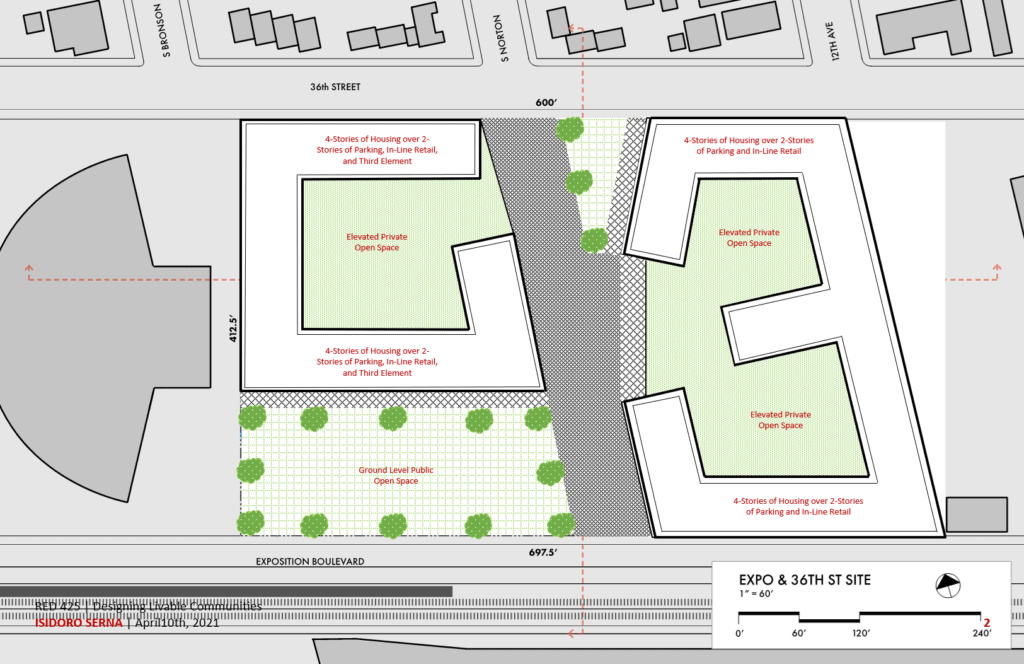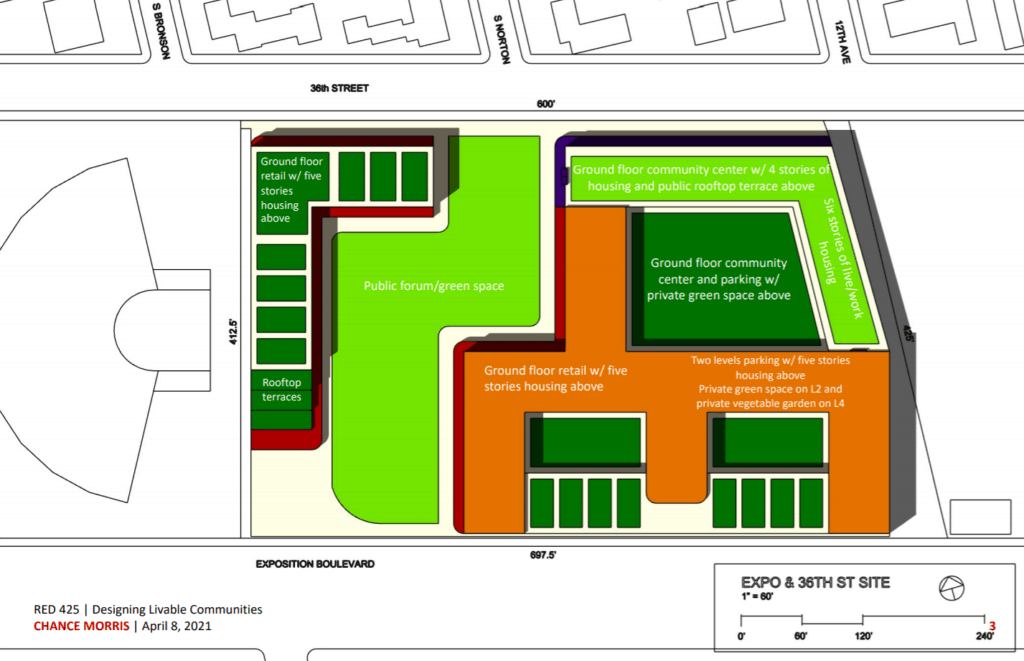By Eric Ruble
Developers and planners frequently cross paths in the real estate industry, but just as often find themselves at odds through ideological differences. However, in the classroom, Real Estate Development (BRED) and Urban Studies and Planning (USP) undergraduates are enjoying a friendly partnership while creating designs together.
“Whether they like to admit it or not, [real estate developers and city planners] are really working together in the same world,” said adjunct professor and real estate executive Joe Lutz, one of the instructors of the USC Price course “Designing Livable Communities.”
Pairs of students are tasked with producing development proposals for two sites in Los Angeles. At one site, the first student plays the role of the developer, envisioning a bold plan for the empty lot; meanwhile, the second student brings that vision to life by designing renderings using the online platform “SketchUp.” At the other site, the students’ roles are reversed.
Professor Liz Falletta led this year’s unique course. “That relationship allows us to mirror those real-world situations where a developer will hire a designer to do a project and also guide their work throughout that process,” Falletta said.
A downtown-adjacent opportunity

This year, one site was at 23rd Street and Grand Avenue, and the other at Crenshaw and Exposition boulevards. At the 23rd and Grand location, the class was asked to include housing and public open space. They also had to develop their own additional element, which many teams used to provide a collaborative space for students from a number of colleges in the downtown area, including Los Angeles Trade Technical College, Mount Saint Mary’s University and USC.
“It was such a broad assignment and you could be creative with where you took it,” said Robert Tiscareno (BRED ‘21) who served as the designer at the site.
His partner Isidoro Serna (USP ‘22) was the developer for 23rd and Grand. He said understanding the community’s needs was a key part of the project.
“This class has taught me a lot regarding design and the role of developers in communities,” Serna said. “You always want to first establish a connection with the community and look into the community and see what they need.”
In fact, students had to include five organizations in the area and name two ways in which they could be incorporated in the development.
Lutz said thoroughly researching the locations was key.
“When you go into someone else’s neighborhood, it’s really important to understand the needs of that neighborhood and the community in that neighborhood,” Lutz said. “You’ll only be successful if you’re delivering a product that that community wants and needs.”

A new chapter for Crenshaw
The second site (at Crenshaw and Exposition) provided an entirely different opportunity for students to flex their development and design muscles. Home to a new Metro line, any development at the site has tremendous potential for success — and failure.
Sabrina Panfil (BRED ‘21) proposed an intergenerational community with abundant open spaces which can be used by people of all ages. Her partner, Miguel Moran (USP ‘22), created a rendering of her development through SketchUp.
“It’s really exciting to see Miguel create my vision and bring that to life, and I was really excited to bring his vision to life,” Panfil said. “You put so many hours into the SketchUp of it, you’re really in awe of this little model by the end.”
Again, students were required to examine residents’ needs and avoid proposals that would serve some Angelenos but not those in the area.
“They are your main demographic for that site. So if they don’t agree with your vision or have conflicting ideas, that can totally stall your development,” Serna said.
Prepping students for real-world challenges
Falletta and Lutz want students to work through challenges they’ll face after leaving Price, like working with people from different backgrounds and industries.
“What I really hope is to turn them into good clients — good future clients of architects who really understand what design can do in terms of contributing to development and city-making,” Falletta said.
“(They) really have to come together and be on the same page to successfully deliver a project. This holds very true, especially in Los Angeles, where these worlds often collide,” Lutz said.

Both professors also want students to leave class with a better understanding of core concepts, such as floor area ratio (FAR). “Sometimes it’s a little bit of a tough love, or sometimes it’s just general knowledge, but what I like to focus on specifically are skills that the students can learn and directly apply to a job,” Lutz said. “To see how far the students get in just a short semester is always very rewarding as a teacher.”
Preparing future leaders requires lived experience
Falletta is a licensed architect and real estate broker. She is the principal of Falletta Development and is an appointed member of the City of Los Angeles’ Zoning Advisory Committee.
A full-time teaching faculty member at Price, she leads a team of adjunct professors who bring real-world perspectives into the classroom.
“When we logged on to each session, [Falletta] would greet every student individually,” Moran said. His partner agreed. “I think she’s one of the most supportive professors,” Panfil said. “She really cares about her students as people first.”
Falletta’s co-instructor is just as experienced. For nearly two decades, Lutz has led mixed-use, retail, office and multifamily developments. He received his master’s of real estate development from USC Price, and served in leadership positions at nationally recognized real estate development firms such as Westfield, GGP (now Brookfield Properties) and Urban Offerings.
“He’s knowledgeable on basically everything that has to do with design because he’s a real-world professional in the field,” said Noah Reyes (BRED ’22), who was in Lutz’s section.
Despite the professors’ demanding schedules, students said they were always accessible and eager to provide advice.
The class provides an invaluable opportunity for students to test ideas they can apply after graduation. Moreover, in order to succeed, they must learn how to compromise. Their final renderings illustrate a dedication to deliver a successful project despite having different goals.
“It was a good insight into the collaboration that you’ll have to do in the real world,” Moran said.
Before the pandemic, on the first day of the course, the entire class would visit the two sites with the instructor. While that wasn’t possible this year, students still embraced the challenge, producing creative plans from scratch and proving their ability to envision a better city for all.